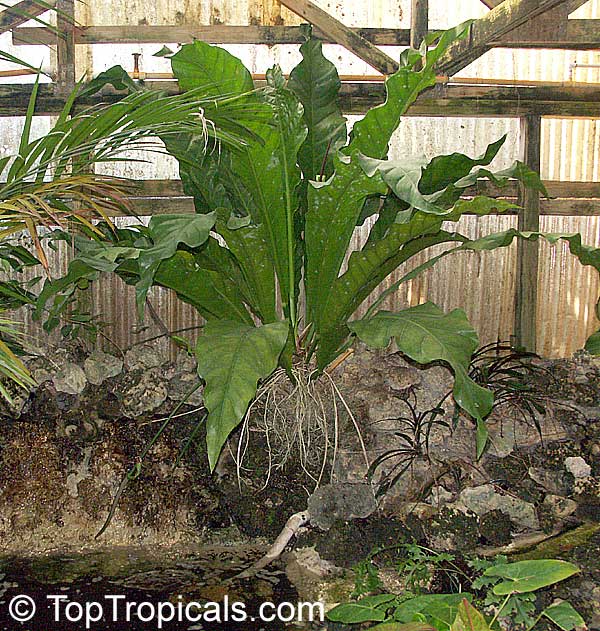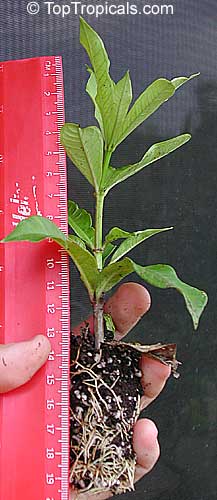MISTHOUSE - PROPAGATION AND RECOVERY SYSTEM
"...Mist house accelerates the process of the plants? DUH! I guess
the answer is yes, but I would like to know why?.." (customer question)
HOW DO PLANTS DRINK WATER?
Water is absorbed by all plant parts. In healthy plant it works as
a pumping station: from roots - through stems - to leaves and flowers/fruits.
Water also absorbed through leaves: from humid air an/or dew.
There are some rainforest species that naturally prefer high air humidity,
and you can't blame them for this like you can't blame seaweed for living
in water.
For most of non-aquatic and non-rainforest plants, when the plant and
especially root system is healthy and developed, the "pumping station"
works just fine and a plant doesn't require extra air humidity within
their natural habitat preferences range (humid tropical climate or dry
desert, etc).
HOW DOES AIR HUMIDITY EFFECT PLANTS?
Two sides of the coin. High air humidity means:
- GOOD: a plant and especially foliage grows much faster. By
providing humid environment, you provide easy access of water to all
plant parts while there is still a good air circulation (humid air is
different than soaking in water where the plant may start rotting in
a few hours without air access unless it's aquatic). Plant doesn't have
to control evaporation in order to save water, so it can grow very large
leaves.
- BAD: by getting used to easy water access, the plant root system
becomes weaker and smaller - the plant simply doesn't need as much roots
any more, water supply comes mostly from absorbing by leaves. This is
why you may see many rainforest species with tiny root systems (bromeliads),
while desert plants like Agave have huge roots going down for many feet
and exceed the plant size many times. Same thing happens to greenhouse
plants that were kept in artificial micro-climate: they sometimes have
small root system and in order to survive outdoors, need some adjustment
period for developing root systems.

USING MIST/FOG HOUSE
Mist house, especially fog-house, has nothing to do with more frequent watering. The idea of the fine mist is to create a humid air creating fine water sprays during short periods of time. Most of the water, ideally, stays as a dredge in the air and doesn't soak the soil. Sometimes mist-houses are equipped with a separate irrigation system - for watering the plants, because if the mist/fog system is made right, it shouldn't provide enough watering for a root system if any.
There are several reasons why you may use a mist-house.
1. For plant propagation: cuttings (no roots to start with, then small
roots)
2. For recovering bare-rooted plants after shipping stress
3. For helping sick plants to recover
In each case, the main purpose of creating a high humidity is to supply
the plant with necessary water amount while it can't obtain it naturally
through root system whether it is damaged or simply doesn't exist.
1. Plant propagation.
The proper procedure to make cuttings differs for different plants and
we won't dicuss it here. You can find more information in books or on
the Internet.
Depending on species, the cuttings are kept under mist for a few weeks
in a loose soil-less mix with lots of perlite (perfect mix is half coconut
fiber and half perlite with a bit of Osmocote as a starter) until well-rooted
(root ball fills the cell). Normal mist mode is: "5 sec on - 2-5
min off".
The main idea is to keep leaves wet (not soil!). If you overdo misting
time, the soil will get wet and cuttings may rot. If you underwater
- leaves will get dry, the cutting gets wilted and will die eventually.
You have to experiment to determine the right timing. When preparing
the cuttings, cut of excess leaves to limit eveporation, but at the
same time make sure to have enough of leaf surface for water absorbing.
If you leave bare twigs, most likely they won't make it because the
stem surface is not enough. The optimal will be 3-4 leaves, and if they
are too large - you may trim them to a half-size or so.
Transplant your rooted cuttings only when they have enough roots developed.
Usually, when the cutting starts growing new leaves and shoots, the
size of the new growth is somewhat proportional to the size of roots.
2. Establishing bare-rooted plants.
After the plant was bare-rooted (all soil was washed off), the root
system pumping ability is practically lost. Micro-roots (hairs) that
actually do the "suction" job, are destroyed. You won't see
those hairs unless you have a microscope. Visually root system stays
intact, but the thick roots are only "vessels" that carry
water to the rest of the plant, while the little hairs do the absorbing
part. So the root system becomes almost useless. It is no more helpful
than other parts of the plant, like stem for example. It absorbs as
much water as any non-root part, while the root tissue is very susceptible
to rot. Slightly overwatered - and the root gets wet, rotted, brown
and dead. If you ever saw overwatered orchid roots, sitting in a wet
sphagnum moss without air circulation - you know what happens.
For establishing bare-rooted plants it is important to provide the following:
- small container - the smaller the better. Don't be afraid to stick a 3 ft tall plant into tiny 4" pot, even to trim roots if needed (they have to re-grow the little "hairs" back anyway, and too huge useless root system will create extra chance for rotting)
- loose porous medium: perlite (a lot), some coconut fiber or soil conditioner (bark). Remember you have to avoid rotting by providing good drainage and good air circulation within the container - only in this case the new "hairs", young roots will grow back.
- fine mist or fog to keep leaves wet at all times to provide plant with enough water through leaves absorption.
Rate of misting depends on plants. Some requires more, some less. Some plants can evene recover in one-two days. Normal mist mode should be like for cuttings to start with, then in 2-3 days decrease frequency of sprays, gradually going down to "5 sec on - 30 min off " schedule in 1-2 weeks. By the end of treatment, you don't have to keep leaves wet at all times unless you see a need.
It's very important not to overwater root system. Make sure plants don't sit in water and have very good drainage. In our experience some plants are encouraged by short period (few hours) of "droughts".

3. Helping sick plants to recover.
This can be done similarly to establishing bare-rooted plants with lighter
effect. Sometimes when the plant's root system is damaged by overwatering,
or the plant came mail-order from a long trip, it may be beneficial to keep
it under mist for a while.
Unlike bare-rooted plant, the sick/stressed plant still has some roots functioning
(unless they are completely destroyed) and doesn't require long treatments.
A side effect can make it worse: if you keep the plant under "pampering"
mist system for too long, it will adjust to "easy living" and stop
working on developing it's own vital systems. Even with bare-rooted plants,
we take them out of mist in 2-3 weeks, no matter if they start complaining
right away: get wilted and look dangerously sad.
We try not to pay attention to this whim and usually after the plants see
no one cares about complains, they gather energy and make it. Only a few plants
that don't seem to be ready after 20-30 hours out of mist, go back to the
misthouse.
You have to run your mist only during daytime. In the darkness, plants don't
do that much of perspiration which means they don't lose water. Right after
sunrise, they wake up and with temperature raising, leaves get dry again.
Control your misthouse with a timer set up from approximately 6-7 am to 6-7
pm, depending on time of the year.
Remember that all you have to do is just keep the leaves wet and soil
slightly moist but not soggy.
LIGHT AND AIR
Filtered bright light is the best. On one hand, you don't burn the tender leaves and keep eveporation under control, on the other hand you still provide enough light for vegetative process. Besides, brighter light kills fungus.
Your misthouse should be covered with planting all the way around. This will keep humid air in and protects sensitive plantings from undesired rain, since you need to control amount of water coming into pots. However, the tricky part is - a) you have to provide good air circulation (you don't want fungus and mold be your guests) and b) with high afternoon temperatures, the plants may get "cooked" under plastic where temperature may reach 90F and higher (critical number). Providing windows and in-window fans at the ceiling level is a good solution.
To limit amount of sun, you may use a shade cloth over the plastic (as many layers as needed) - this will also desrease temperature inside. Plastic reflecting film or paint can be also helpful.
 frdg
frdg
FERTILIZING
When you plant cuttings or bare-rooted plants in a well-drained medium that is not susceptible to rot, most likely this medium doesn't have much organic in it, which means nutrients. Once your plant started to root or recover, it will continue growing, and will need not only water, but food as well. This is why we add a bit of slow-release fertilizer in propagation mix - so once the plant has a tiny root, the meal is ready for it. However, even with fine fog the soil gets flushed very soon, and no nutrients left. After the first new roots or shoots appeared, apply some fertilizer. You may add more slow-release granules like Osmocote or Dynamite, or spray with 1/2-1/4 doze of water-soluble fertilizer over the foliage once a week, at evening hours.
Using Micro-elements supplement is even more important for young and establishing plants. Iron-deficiency is a very common problem with cuttings and stressed plants.

ADDITIONAL TREATMENTS
We recommend applying natural hormones Epin and Cirkon
for:
- soaking cuttings before propagation
- spraying potted plants - sick or after bare-rooting (in the evening, so
the hormone stays on leaves overnight without being washed-off)
In addition to stimulation functions, the treatments with Cirkon will protect your plants from fungus which can be a serious problem in hot and humid environment. The propagation/potting mix should be watered with Cirkon solution once, before setting up a mist schedule.
Pre-treatment of pots/cells before potting with bleach and/or copper anti-fungicide will be useful, too (must rinse well afterwards).
